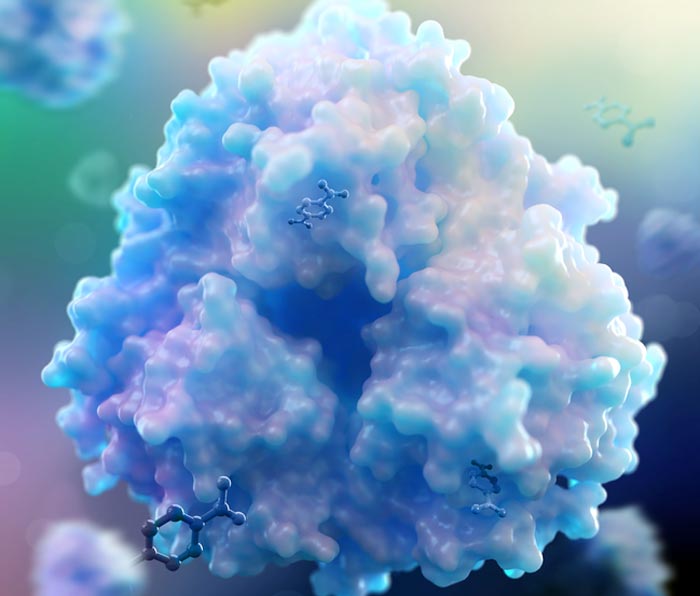New enzyme discovery …

The TPADO enzyme
Credit: Rita Clare, Montana State University
… is another leap towards beating plastic waste.
Scientists who helped to pioneer the use of enzymes to eat plastic have taken an important next step in developing nature-based solutions to the global plastics crisis.
They have characterised an enzyme that has the remarkable capacity to help break down terephthalate (TPA), one of the chemical building blocks of polyethylene terephthalate (PET) plastic, which is used to make single-use drinks bottles, clothing and carpets.
The research, which is published in The Proceedings of the National Academy of Sciences (PNAS), was co-led by Professor Jen DuBois, Montana State University, and Professor John McGeehan from the University of Portsmouth, who in 2018 led the international team that engineered a natural enzyme that could break down PET plastic. The enzymes (PETase and MHETase) break the PET polymer into the chemical building blocks ethylene glycol (EG) and TPA. This new research describes the next steps, specifically for managing TPA.
Professor DuBois said: “While EG is a chemical with many uses – it’s part of the antifreeze you put into your car, for example – TPA does not have many uses outside of PET, nor is it something that most bacteria can even digest. However, the Portsmouth team revealed that an enzyme from PET-consuming bacteria recognises TPA like a hand in a glove. Our group at MSU then demonstrated that this enzyme, called TPADO, breaks down TPA and pretty much only TPA, with amazing efficiency.”
With more than 400 million tons of plastic waste produced each year, the overwhelming majority of which ends up in landfills, it is hoped this work will open the door to improve bacterial enzymes, such as TPADO. This will help tackle the challenge of plastic pollution and develop biological systems that can convert waste plastic into valuable products.
Professor McGeehan, who is the Director of the University’s Centre for Enzyme Innovation, said: “The last few years have seen incredible advances in the engineering of enzymes to break down PET plastic into its building blocks. This work goes a stage further and looks at the first enzyme in a cascade that can deconstruct those building blocks into simpler molecules. These can then be utilised by bacteria to generate sustainable chemicals and materials, essential making valuable products out of plastic waste.
“Using powerful X-ray at the Diamond Light Source, we were able to generate a detailed 3D structure of the TPADO enzyme, revealing how it performs this crucial reaction. This provides researchers with a blueprint for engineering faster and more efficient versions of this complex enzyme.”
The study was undertaken as part of the BOTTLE Consortium, an international collaboration between the US and UK, bringing together researchers from across a wide range of scientific areas to tackle plastic recycling and upcycling.
Journal: Proceedings of the National Academy of Sciences
Method of Research: Computational simulation/modeling
Subject of Research: Not applicable
Article Title: Biochemical and structural characterization of an aromatic ring–hydroxylating dioxygenase for terephthalic acid catabolism
Article Publication Date: 25-Mar-2022
Media Contact
Glenn Harris
University of Portsmouth
glenn.harris@port.ac.uk
Office: 0239-284-2728
All latest news from the category: Life Sciences and Chemistry
Articles and reports from the Life Sciences and chemistry area deal with applied and basic research into modern biology, chemistry and human medicine.
Valuable information can be found on a range of life sciences fields including bacteriology, biochemistry, bionics, bioinformatics, biophysics, biotechnology, genetics, geobotany, human biology, marine biology, microbiology, molecular biology, cellular biology, zoology, bioinorganic chemistry, microchemistry and environmental chemistry.
Newest articles

Why getting in touch with our ‘gerbil brain’ could help machines listen better
Macquarie University researchers have debunked a 75-year-old theory about how humans determine where sounds are coming from, and it could unlock the secret to creating a next generation of more…

Attosecond core-level spectroscopy reveals real-time molecular dynamics
Chemical reactions are complex mechanisms. Many different dynamical processes are involved, affecting both the electrons and the nucleus of the present atoms. Very often the strongly coupled electron and nuclear…

Free-forming organelles help plants adapt to climate change
Scientists uncover how plants “see” shades of light, temperature. Plants’ ability to sense light and temperature, and their ability to adapt to climate change, hinges on free-forming structures in their…





















